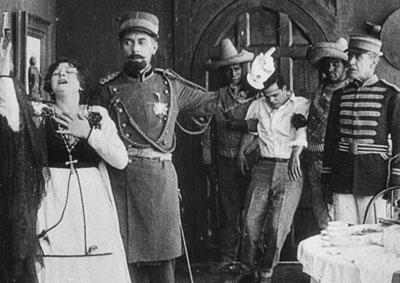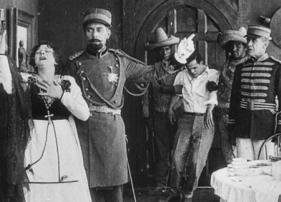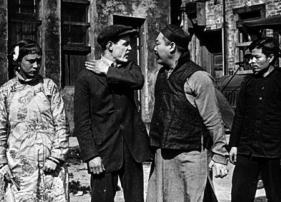Directed by Rex Ingram
Universal Film Mtg. Co. Bluebird Photoplays. Producer: Sam Bischoff. Screenwriter: R. Ingram. Cinematographer: Duke Hayward, George W. Lawrence. With: Cleo Madison, Blanche White, Charles Cummings, John McDermott, Wedgewood Nowell. 35mm, tinted and b/w, approx. 70 min.
Following the success of their first full-length movie (Traffic In Souls in 1913), the Universal Film Manufacturing Company soon began feature film production in earnest, resulting in the hiring of an unproven directorial prospect named Rex Ingram in 1916.
Ingram (born in Ireland in 1893 as Reginald Ingram Montgomery Hitchcock) initially became interested in motion pictures while studying sculpture at Yale University. One night after watching Vitagraph’s 3-reel version of Charles Dickens’ A Tale Of Two Cities (a film also preserved by UCLA), he became convinced that his fertile imagination would best be served in the world of filmmaking, and secured a position with the Edison Company where he both wrote and acted. Following short assignments at Vitagraph and Fox, Ingram was lured to Universal with the promise that he would be allowed to direct his own films. After helming his first two features in New York, Ingram would make The Chalice Of Sorrow at the recently opened Universal City studio lot in southern California.
The plot is loosely based on Victorien Sardou’s dramatic play La Tosca (indeed, at least one European release of this film bore that title), although Ingram relocated the setting from Rome to Mexico City. Lorelei, a world-renowned opera star, is pursued ardently by two men: Francisco De Sarpina, a powerful Mexican provincial governor, and Marion Leslie, an American artist who is her secret fiancé and true love. Infatuated with Lorelei, De Saprina implicates his rival in the escape of a falsely accused murder suspect, and subsequently tortures and imprisons him. With Marion held captive behind bars, De Sarpina presents Lorelei with a most daunting dilemma: either she must acquiesce to his licentious desires or her lover will be executed by firing squad. A deal is ultimately struck—one that has dire consequences for all concerned.
For the lead role of Lorelei, Ingram chose Cleo Madison, an actress he admired for her “natural” acting technique (she also starred in Ingram’s Black Orchid). The villain De Sarpina is played by Wedgwood Nowell, who would also appear in four of Ingram’s other Universal films—including this evening’s second feature, The Flower Of Doom.
Steven K. Hill
Preserved in cooperation with Filmarchiv Austria from a 35mm nitrate print. Laboratory services by The Stanford Theatre Film Laboratory, Title House Digital.






 Mobile Navigation
Mobile Navigation



